30-30 Vs. 45-70 : Which Cartridge Is a Better Choice?
What You Need to Know About 30-30 Vs. 45-70 Lever Action Rifle Ammo.
If you ask the recommendations for top lever action calibers, the 30-30 Win and the 45-70 govt will be the best option. Both are proven cartridges with over a century of use, and both can deliver the performance you need from a lever action rifle.
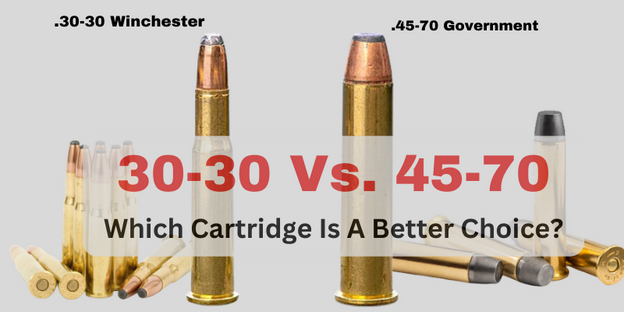
Now the question is 30-30 Vs. 45-70; which is better? The choice will always depend on the individual's requirements. Still, you must understand the differences between both calibers to choose the better one.
Check our previous post about : 300 Blackout vs 7.62x39
Let's get started to know the difference between.30-30 vs 45-70.
30-30 Vs. 45-70: Specifications
| Specifications | 30-30 Win | 45-70 Gov. |
| Parent Case | 38-55 Win | Unique Design |
| Bullet Diameter | 0.308 in | 0.458 in |
| Bullet Size | 308 inches | .458 inches |
| Muzzle Energy | 2,046 ft/lbs | 2942 ft/lbs |
| Muzzle Velocity | 2,400 ft/s | 2350 ft/s |
| Overall Length | 2.550 in | 2.550 in |
| Case Capacity | 45 Grains | 81.8 grains |
| Neck Diameter | 0.330 in | 0.480 in |
| Max Pressure | 42,000 psi | 28,000 psi |
30-30 Vs. 45-70: Overview And History
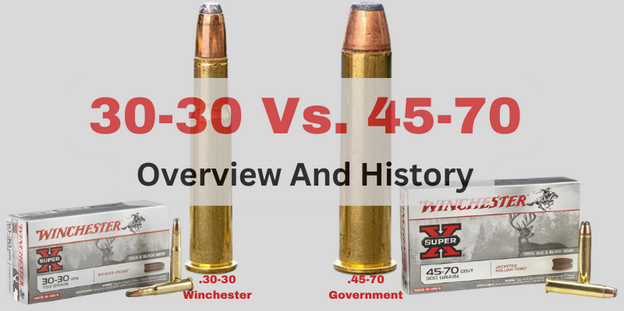
The 30-30 and 45-70 are popular rifle cartridges with unique features and advantages. The 30-30 cartridge is known for its accuracy at moderate ranges and relatively light recoil, making it a popular choice for hunting medium-sized games such as deer.
It has a maximum effective range of around 200 yards and is often used in lever-action rifles.
On the other hand, the 45-70 cartridge is a more powerful one designed for larger games such as Bear and Moose. It has a maximum effective range of around 400 yards and is often used in single-shot or lever-action rifles. It also has a heavier recoil compared to the 30-30.
30-30 Ammo Overview & History
The .30-30 Winchester cartridge, also known as the .30 Winchester Centerfire or .30 WCF, was introduced by Winchester in 1895 for use in their lever-action rifles.
The cartridge was originally designed for use in hunting medium-sized game, such as deer and black bear, at ranges up to 200 yards. It quickly became popular with hunters and sportsmen in North America and remains a popular choice for hunting today.
The 30-30 cartridge is a centerfire cartridge with a bullet diameter of .308 inches, which is why it is sometimes referred to as the .30 Winchester Centerfire or .30 WCF. It has a typical bullet weight of 150-170 grains and a muzzle velocity of around 2,300-2,400 feet per second.
Over the years, the 30-30 cartridge has undergone various modifications and improvements, including adding pointed bullets and using smokeless powder. It remains a popular cartridge for hunting and recreational shooting and is commonly used in lever-action rifles such as the Winchester Model 94 and Marlin Model 336.
In addition to hunting, the 30-30 cartridge is also popular in cowboy action shooting competitions, where shooters used rifles and revolvers from the late 1800s to the early 1900s. The 30-30 cartridge provides a good balance of power, accuracy, and recoil for this type of shooting.
The 30-30 cartridge has a long and rich history and remains popular for shooting applications.
45-70 Ammo Overview & History
The .45-70 Government cartridge, also known as the .45-70 Springfield, was developed by the U.S. Army in 1873 for use in their Springfield Model 1873 rifle. It was initially intended for use by cavalry troops and infantrymen in garrison and guard duty.
The cartridge uses a .45 caliber bullet weighing between 300 and 500 grains, typically propelled at around 1,300 to 1,400 feet per second. The initial loading used a black powder charge of 70 grains, where the cartridge's name comes from.
The .45-70 cartridge quickly became popular with hunters and sportsmen in the late 19th century and was used for hunting large game such as bison, elk, and bear. Frontiersmen and settlers also used it for protection against wild animals and Native American attacks.
Over the years, the .45-70 cartridge has been used in various rifles, including lever-action rifles from Winchester and Marlin and single-shot and bolt-action rifles. It has also been adapted for use in some handguns.
Today, the .45-70 remains a popular choice for hunting big game, particularly in regions where shots are typically taken at ranges of less than 200 yards. It is also used in some shooting competitions and for recreational shooting. Several different loads are available for the .45-70 cartridge, including those designed for target shooting, hunting, and self-defense.
45-70 Vs. 30-30: Cartridge Sizes
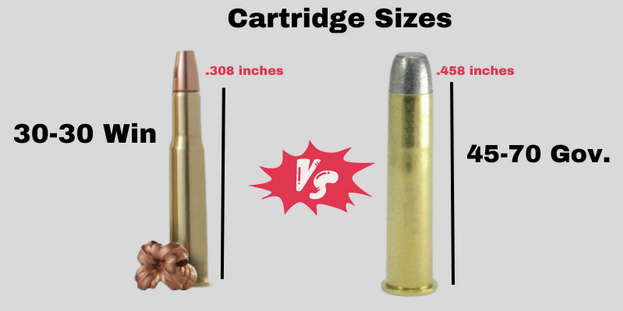
The .30-30 Winchester and .45-70 Government cartridges are two of the most popular for hunting in North America, but they significantly differ in size and power.
The .30-30 cartridge has a bullet diameter of .308 inches and a case length of 2.039 inches. The overall size of the cartridge is 2.554 inches, and it typically uses a bullet weighing 110 and 170 grains. The muzzle velocity of a .30-30 cartridge can range from around 2,000 to 2,400 feet per second, depending on the specific load.
The .45-70 cartridge has a bullet diameter of .458 inches and a case length of 2.105 inches. The overall size of the cartridge is 2.550 inches, and it typically uses a bullet weighing between 300 and 500 grains. The muzzle velocity of a .45-70 cartridge can range from around 1,300 to 2,000 feet per second, depending on the specific load.
As you can see, the .45-70 cartridge is larger in bullet diameter and case length than the .30-30 cartridge. This generally means the .45-70 cartridge can deliver more energy and greater stopping power than the .30-30 cartridge, particularly at longer ranges.
However, the .30-30 cartridge is typically lighter, more compact, and easier to handle than the .45-70 cartridge, making it a popular choice for hunting in brushy or heavily wooded areas. Choosing between these cartridges will ultimately depend on the specific hunting situation and the shooter's preferences.
30-30 Vs. 45-70: Performance
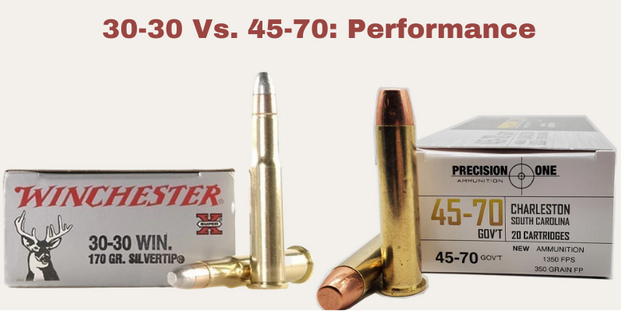
Regarding performance, the .30-30 Winchester and .45-70 Government cartridges have distinct differences due to their size and design.
The .30-30 cartridge is a moderate-powered round popular for hunting medium-sized games at ranges up to 200 yards. It has a reputation for being accurate, reliable, and easy to shoot, making it a popular choice for beginners and experienced hunters alike.
The typical bullet weights for the .30-30 cartridge range from 110 to 170 grains, and the muzzle velocity ranges from around 2,000 to 2,400 feet per second. The effective range of the .30-30 cartridge is generally about 150-200 yards, although some hunters have taken game at longer distances.
In contrast, the .45-70 cartridge is a large, powerful round designed for hunting large and dangerous games at shorter ranges. It has a reputation for delivering energy and stopping power, making it a popular choice for hunters pursuing games such as moose, elk, and bear.
The typical bullet weights for the .45-70 cartridge range from 300 to 500 grains, and the muzzle velocity ranges from around 1,300 to 2,000 feet per second. The effective range of the .45-70 cartridge is generally about 200 yards or less, although some hunters have taken game at longer distances.
The .45-70 cartridge is more powerful and capable of delivering greater stopping power than the .30-30 cartridge, particularly at shorter ranges. However, the .30-30 cartridge is generally more accurate and easier to handle than the .45-70 cartridge, making it a popular choice for hunting in brushy or heavily wooded areas.
Choosing between these cartridges will ultimately depend on the specific hunting situation and the shooter's preferences.
30-30 Vs. 45-70: Ballistics
The .30-30 Winchester and .45-70 Government cartridges are popular rifle cartridges in the United States, with a long history of use in hunting and shooting. Here's a breakdown of the ballistics of each cartridge:
The .45-70 Government cartridge generally shoots heavier bullets at slower velocities but with more muzzle energy than the .30-30 Winchester cartridge. This makes the .45-70 a better choice for the larger game at shorter ranges, while the .30-30 is better suited for the medium-sized game at moderate degrees. The .45-70 is also popular among black powder cartridge shooters and has a strong following among traditional or historical firearms enthusiasts.
| 30-30 | 45-70 | |
| Bullet weight | 110-170 grains | 250-500 grains |
| Muzzle velocity | 3,000/2998 feet per second* | 2,050/ 3,033 feet per second* |
| Muzzle energy | 1,600-1,900 foot-pounds | 1,800-3,500 foot-pounds |
| 100 yards Trajectory Inch/energy | 0/2,535 | 0/2,159 |
| 200 yards Trajectory Inch/energy | -3.1/2,125 | -10.3/1,519 |
| 300 yards Trajectory Inch/energy | -11.7/ 1,771 | -37.2/1,083 |
| 400 yards Trajectory Inch/energy | -26.8/1,465 | -87.3/827 |
| 500 yards Trajectory Inch/energy | -49.8/1,202 | 167.7/683 |
30-30 Vs. 45-70: Power and Range
The .30-30 Winchester and .45-70 Government cartridges are popular choices for hunting and shooting sports, but they have significant differences in power and range.
The .30-30 Winchester cartridge is a medium-power round that has been in use for over a century. It fires a bullet that typically weighs between 110 and 170 grains and has a muzzle velocity of around 2,200 to 2,500 feet per second (fps). The effective range of the .30-30 is usually around 200 to 300 yards.
In contrast, the .45-70 Government cartridge is a much more powerful round originally developed for military rifles. It fires a bullet that typically weighs between 300 and 500 grains and has a muzzle velocity of around 1,300 to 1,500 fps. The effective range of the .45-70 is usually about 400 to 500 yards.
Overall, the .45-70 Government cartridge is more powerful and has a longer effective range than the .30-30 Winchester cartridge. However, the .30-30 is still popular for hunting and shooting sports due to its affordability, availability, and effectiveness at shorter ranges.
30-30 Vs. 45-70: Recoil
The recoil of a firearm is determined by a combination of factors, including the weight of the gun, the weight and velocity of the bullet, and the amount of gunpowder used to propel the bullet.
Between the .30-30 Winchester and .45-70 Government cartridges, the .45-70 typically produces more recoil due to its heavier bullet and higher powder charge. However, the perceived recoil also depends on the weight and design of the specific firearm.
Generally, a heavier rifle with a longer barrel typically has less felt recoil than a lighter rifle with a shorter barrel, all else being equal. Additionally, the design of the stock and the recoil pad can also impact the perceived recoil.
30-30 Vs. 45-70: Application
The 30-30 and 45-70 are two popular types of ammunition used for hunting and shooting. Both cartridges have different applications based on their characteristics and capabilities.
The 30-30 cartridge is a rimmed cartridge typically used for medium-range hunting, such as deer and other small to medium-sized game animals.
The 45-70 cartridge is typically used for big game hunting, such as moose, elk, and bear. The 45-70 cartridge is better suited for larger game animals and longer-range shooting.
30-30 Vs. 45-70: Weapon Selection
Many good firearms options are available when choosing the right weapon for 30-30 & 45-70 calibers. Henry, Winchester, Marlin, and Rossi produce weapons for these cartridges.
A 30-30 rifle is generally lighter, more compact, and easier to handle than a 45-70 rifle. It is a popular choice for hunting and target shooting, especially for those who prefer a lighter rifle with less recoil. A 30-30 rifle can also be a good option for beginners, as it is generally easier to shoot accurately than a 45-70.
A 45-70 rifle, on the other hand, is a heavier and more powerful firearm. It is generally better suited for hunting big games at longer ranges and can also be used for long-range shooting competitions. However, it can be more challenging due to its heavier weight and greater recoil.
When selecting a firearm, it is important to consider the intended use and personal preferences. If you plan to hunt medium-sized games at shorter ranges, a 30-30 rifle may be better.
If you plan to hunt larger games at longer ranges or participate in long-range shooting competitions, a 45-70 rifle may be better. It is also important to consider your physical ability to handle the firearm, as a heavier rifle with greater recoil can be more difficult for some individuals.
30-30 Vs. 45-70 - Price & Availability
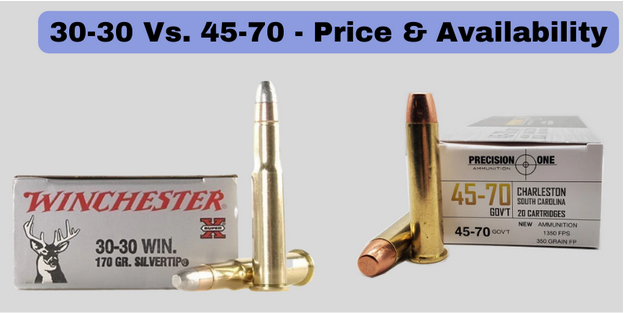
The price and availability of ammunition for the 30-30 and 45-70 cartridges can vary depending on various factors such as location, demand, and manufacturer.
The 30-30 cartridge is widely available and relatively inexpensive. It is also commonly found in many sporting goods stores and online retailers. The price for a box of 20 rounds of 30-30 ammunition can range from around $15* to more, depending on the brand and type of bullet.
On the other hand, the 45-70 cartridge is a larger and more powerful round often used for hunting large game such as bear and elk. Due to its size and power, it is generally more expensive than the 30-30. A box of 20 rounds of 45-70 ammunition can cost anywhere from $40* to more, depending on the brand and type of bullet.
.30-30 cartridges are less restricted than .45-70 cartridges and much cheaper. For the .45-70 round, availability is limited. 405-grain ammo is available from Remington Core-Lokt, priced at around $2.25* per round.
A .30-30 ammunition with between 150 and 170 grains is available from Remington Core-Lokt, costing approximately $1.15* per round.
30-30 Vs. 45-70: Pros & Cons
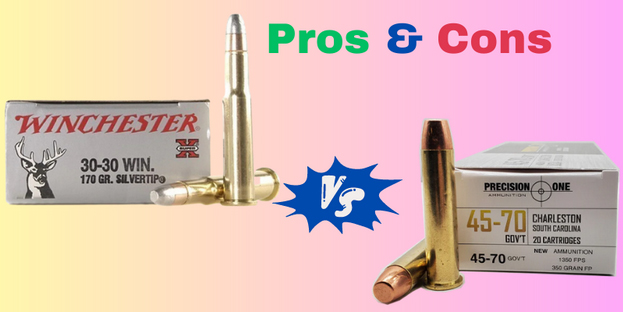
30-30 Pros & Cons
Pros
 Flat trajectory: The 30-30 has a relatively flat trajectory, which makes it easier to shoot accurately at medium ranges.
Flat trajectory: The 30-30 has a relatively flat trajectory, which makes it easier to shoot accurately at medium ranges. Light recoil: The 30-30 produces less recoil than many other rifle cartridges, making it more comfortable to shoot for some people.
Light recoil: The 30-30 produces less recoil than many other rifle cartridges, making it more comfortable to shoot for some people. Lightweight: Rifles chambered in 30-30 are generally lighter and more compact than rifles chambered in larger cartridges, making them easier to carry in the field.
Lightweight: Rifles chambered in 30-30 are generally lighter and more compact than rifles chambered in larger cartridges, making them easier to carry in the field.
Cons
 Limited range: The 30-30 is best suited for shooting at ranges up to about 200 yards. Beyond that, the bullet starts to lose velocity and energy, which can make it less effective.
Limited range: The 30-30 is best suited for shooting at ranges up to about 200 yards. Beyond that, the bullet starts to lose velocity and energy, which can make it less effective. Limited power: The 30-30 is less powerful than larger cartridges, so it may not be suitable for taking down the larger game at longer ranges.
Limited power: The 30-30 is less powerful than larger cartridges, so it may not be suitable for taking down the larger game at longer ranges. Limited bullet selection: More bullet options are available for the 30-30 compared to other cartridges, which may limit the cartridge's versatility.
Limited bullet selection: More bullet options are available for the 30-30 compared to other cartridges, which may limit the cartridge's versatility.
45-70 Ammo Pros & Cons
Pros
 High power: The 45-70 cartridge can take down big games at longer ranges.
High power: The 45-70 cartridge can take down big games at longer ranges. Versatile: The 45-70 can shoot a wide range of bullet weights and styles, making it a versatile cartridge for different types of hunting.
Versatile: The 45-70 can shoot a wide range of bullet weights and styles, making it a versatile cartridge for different types of hunting. Durable: Rifles chambered in 45-70 are often built on strong actions and can handle heavy recoil, making them durable and long-lasting.
Durable: Rifles chambered in 45-70 are often built on strong actions and can handle heavy recoil, making them durable and long-lasting.
Cons
 Heavy recoil: The 45-70 produces significant recoil, which can be uncomfortable or even painful for some shooters.
Heavy recoil: The 45-70 produces significant recoil, which can be uncomfortable or even painful for some shooters. Limited range: While the 45-70 is powerful, its trajectory is more arcing than flat, making it best suited for shooting at shorter ranges.
Limited range: While the 45-70 is powerful, its trajectory is more arcing than flat, making it best suited for shooting at shorter ranges. Heavy and bulky: Rifles chambered in 45-70 are often heavier and bulkier than rifles chambered in smaller cartridges, making them more difficult to carry in the field.
Heavy and bulky: Rifles chambered in 45-70 are often heavier and bulkier than rifles chambered in smaller cartridges, making them more difficult to carry in the field.
Conclusion
Both the 30-30 Vs. 45-70 have pros and cons; the best choice for a particular shooter depends on their needs and preferences.
The 30-30 is better for someone who wants a lightweight, easy-to-carry rifle for hunting medium-sized games at shorter ranges. The 45-70 is a better choice for someone who wants a powerful and versatile cartridge for hunting big games at longer ranges.

